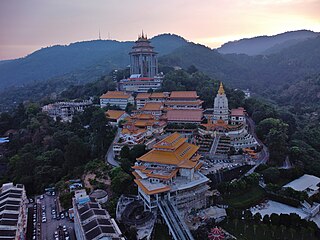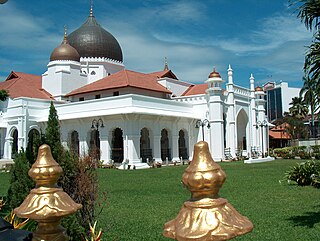
The Kek Lok Si Temple is a Buddhist temple within the city of George Town in the Malaysian state of Penang. Located at Ayer Itam, it is the largest Buddhist temple in Malaysia and an important pilgrimage centre for Buddhists from Hong Kong, the Philippines, Singapore and other parts of Southeast Asia. The entire complex of temples was built over a period from 1890 to 1930, an inspirational initiative of Beow Lean, the abbot. The main feature of the complex is the seven-story Ten Thousand Buddhas Pagoda commissioned by the late Thai king Rama VI, featuring 10,000 alabaster and bronze statues of Buddha and the 36.57-metre-tall (120 ft) bronze statue of Guanyin, the Goddess of Mercy. The 10,000 Buddhas concept belongs to the Chinese Mahāyāna school of Buddhism while Rama VI was king over a Theravāda country and Buddhist tradition.

The Cheng Hoon Teng Temple is a Chinese temple practising the Three Doctrinal Systems of Buddhism, Confucianism and Taoism located at No. 25 Jalan Tokong, Malacca City, Malaysia. It is the oldest functioning temple in the country.

Petaling Street is a Chinatown located in Kuala Lumpur, Malaysia. The whole vicinity is also known as Chinatown KL. Haggling is a common sight here and the place is usually crowded with locals as well as tourists.
Keling or Kling is an exonym to denote a Tamilian or someone deemed to have originated from South India. Originally a neutral term, since the mid-20th century it has been considered derogatory and an ethnic slur, and it is sometimes euphemistically referred to as the K-word. The term is used in parts of Southeast Asia, particularly the Malay Archipelago where there are a significant Tamil diaspora – specifically Malaysia, Indonesia, Singapore and Brunei – but cognates exist in neighbouring countries as well.

The Kapitan Keling Mosque is a mosque built in the 19th century by Indian Muslim traders in George Town, Penang, Malaysia. It is situated on the corner of Buckingham Street and Pitt Street. Being a prominent Islamic historic centre, it is part of the World Heritage Site of George Town and lies at the centre of the city's Tamil Muslim neighbourhood, the chulias. It is the first permanent Muslim institution to have been established in the area, dating from the early 1800s. Cauder Mohuddeen Merican is known as the founder of the mosque and leader of the Chulias. In 1801 Sir George Leith, who was then Lieutenant Governor of Penang, appointed a prominent Indian Muslim leader, Cauder Mohudeen, as Captain of the South Indian “Keling” community. He granted a piece of land to build a mosque on the south side of Malabar Street. Cauder Mohudeen was a ship mandoor or foreman from Porto Novo, which the Tamils called Parangipettai and the Muslims Mahmudbandar, about 50 kilometres south of Pondicherry in India. He was referred to as 'Kapitan Kling'.

Kampong Kling Mosque is an old mosque in Malacca City, Malacca, Malaysia. It is situated at Jalan Tukang Emas, also known as "Harmony Street" because of its proximity to the Sri Poyatha Moorthi Temple and Cheng Hoon Teng Temple.

The Arulmigu Sri Mahamariamman Temple is a Hindu temple within George Town in the Malaysian state of Penang. The oldest Hindu temple in the state, it was built in 1833, and features sculptures of gods and goddesses over its main entrance and facade.

Tourism in Malaysia is a major industry and contributor to the Malaysian economy. Malaysia was once ranked 9th in the world for tourist arrivals. In 2017, the Travel and Tourism Competitiveness Report ranked Malaysia 26 out of 141 countries using its Travel & Tourism Competitiveness Index (TTCI) which measures the various components and policies of a country that are in place to allow for the sustainable development of its travel and tourism sectors.

Batu Uban is a residential neighbourhood within the city of George Town in the Malaysian state of Penang, about 6.7 km (4.2 mi) south of the city centre. Founded by ethnic Minangkabaus in the early 18th century, Batu Uban is regarded as the oldest Malay settlement on Penang Island.

Green Lane is a major thoroughfare within the city of George Town in the Malaysian state of Penang. Part of Penang Middle Ring Road, Green Lane starts from the intersection with Scotland and Ayer Itam roads, and stretches southwards to the Udini Roundabout.

The Goddess of Mercy Temple, also known as Kuan Im Teng or Kong Hock Keong, is a Mahayana Buddhist temple within George Town in the Malaysian state of Penang. Located at Pitt Street, it was built in 1728, making it the oldest Buddhist temple in the state.

Chung Hwa Confucian Secondary School is a Chinese conforming (national-type) secondary school located in Green Lane, Penang, Malaysia. The school is one of 10 Chinese secondary schools in Penang and also has a good record of co-curriculum and public examination results.

Little India is an ethnic Indian enclave located within the downtown core of George Town within the Malaysian state of Penang. The oldest Hindu temple in Penang, Sri Mahamariamman Temple is located here.

The Arulmigu Balathandayuthapani Temple, also known as the Waterfall Hilltop Temple, is a Hindu temple within George Town in the Malaysian state of Penang. Dedicated to Lord Murugan, the hilltop temple, with its seven-storey 21.6 m-tall gopuram, has been touted as the largest Lord Murugan temple outside India. It is sited comparatively higher above ground than Batu Caves, with devotees having to climb over 500 steps to access the place of worship.

Kampung Madras, formerly known as Kampung Keling, is the Little India of Medan, Indonesia, and one of the city's significant ethnic enclaves. Kampung Madras encompasses an area of approximately 10 hectares, and hosts a large Indian. Now a now part of the Medan Polonia district, Kampung Madras is home to many sporting goods resellers, sari stores, and other shophouses.
The Hindu Mahajana Sangam is an association of Indian workers. It is one of the Indian non-profitable organization at Penang, Malaysia which has been officially established in 1935 by waterfronts workers. Before 1935, it known as Kootakkadai .

Burmah Road is a major thoroughfare in the city of George Town within the Malaysian state of Penang. The 3.7 km (2.3 mi) long road is a major artery leading out of the city centre towards the suburb of Tanjong Tokong.

Padang Kota is a state constituency in Penang, Malaysia, that has been represented in the Penang State Legislative Assembly since 1974. It covers George Town's historic city centre, including its old administrative core and the central business district (CBD) at Beach Street.






















